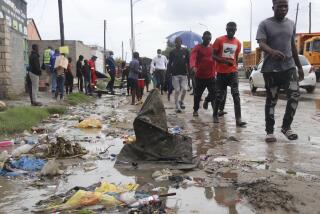To drive down Ebola transmission, saying goodbye to the dead must change
Traditional West African funerals, at which mourners extensively touch and kiss the dead, are “superspreader” events for transmission of the Ebola virus, says a new study, which identified hygienic burial practices of those who have succumbed to the infection as the single-most effective way to slow the epidemic.
A team that included researchers from Liberia’s Ministry of Health and Social Welfare also concluded that a government-imposed quarantine of the West Point slum in Monrovia, which lasted 10 days and galvanized an angry community backlash, did little to slow the spread of the Ebola virus.
The cordon sanitaire, imposed by Liberian President Ellen Johnson Sirleaf and enforced by Liberian police, “may have even been detrimental, given the civil unrest” touched off by the measures, the study said.
The new research, published Thursday in Science Magazine, uses mathematical models to assess the relative impacts of a range of measures that would stem transmission of the Ebola virus. Epidemiologists from Oregon State University, Yale University and Liberia’s public health agency found that the practice of washing, touching and kissing the dead in preparation for burial was the single-most potent factor in escalating the rate at which the virus was transmitted in the early days of the outbreak.
The broader adoption of safe burial practices thus would do most to de-escalate transmission, they reasoned.
Such practices include disinfecting the cadaver before it is placed in a plastic body bag, which would then also be disinfected.
But the abandonment of the region’s funereal tradition will not by itself cause the rate of infection to decline far enough for Liberia’s epidemic to burn itself out, the authors of the study concluded. For that to happen, the Ebola virus’ reproductive rate -- the number of people infected by each person sick with Ebola -- would have to drop to below 1.
Given the measures in place in Liberia on Sept. 19, the researchers said, the Ebola virus’ reproductive rate in Liberia rests at about 1.63. That means, on average, that for every two people who contract the virus, just over three will be infected. At that rate of reproduction, the epidemic will continue to expand. Measures that get the reproductive rate below 1, however, should lead to a gradual “fizzling” of the epidemic.
To achieve that goal, more Liberian health workers must adopt measures -- mainly the wearing of personal protective equipment -- to stem the transmission of virus in hospitals. And Liberia’s overwhelmed public health workers must do a better job of isolating in hospitals those infected with the virus and tracing and monitoring those with whom the infected have come into close contact.
If performance on all three sets of measures improves 80% from levels in place on Sept. 19, the researchers calculated, Liberia could reverse the course of the epidemic in six months.
Nearly six weeks has passed since the baseline assumed by the study authors’ was calculated, and it’s likely that the expansion of international aid has begun to make inroads in all three areas. But the authors cautioned that Ebola deaths -- and as a result, Ebola transmissions -- likely continue unabated and unreported throughout Liberia.
Perhaps the disease is underreported because Liberians fear coming forward when they are sick. Or it may be underreported because not all who are infected develop symptoms of the disease. But to the extent that that’s so, the authors warned, their calculations of what’s needed to bring the Ebola epidemic under control underestimate the challenge ahead. And that, they said, only adds urgency to the need for more effective control measures.
Twitter: @LATMelissaHealy






